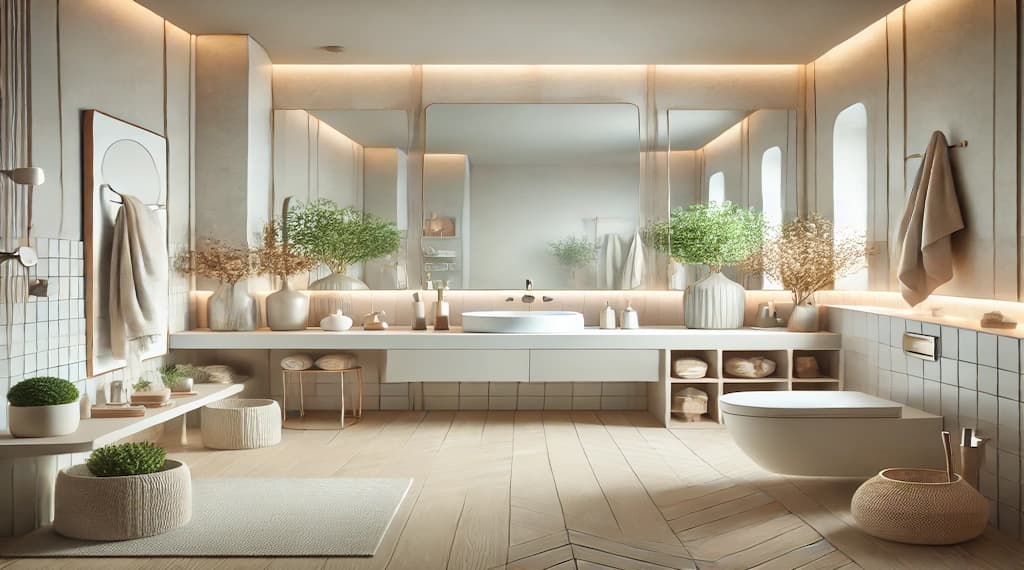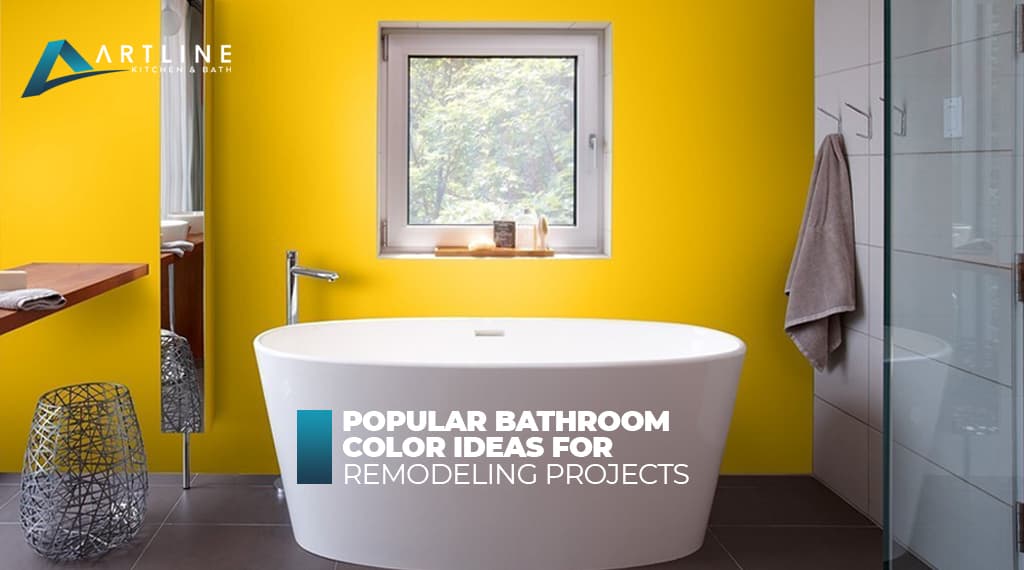Popular bathroom color ideas are central to a successful bathroom remodeling project, helping to set the tone and style of the space. Whether you’re aiming to create a tranquil retreat with soft blues and greens or a bold statement with deep, dramatic hues, the right colors enhance any bathroom remodeling service by making the room feel more personalized and cohesive.
In a bathroom remodeling plan, color choices work hand in hand with lighting, fixtures, and layout to ensure that the space is both stylish and functional. Integrating colors that suit the bathroom’s size and natural lighting creates a balanced atmosphere, which is essential for any well-executed bathroom remodeling project.
Color psychology plays a significant role in how we experience a space, especially in a bathroom where relaxation and rejuvenation are key. Cool tones like blues and greens evoke calmness and serenity, making them ideal for bathrooms designed for relaxation. Warmer colors like yellows and oranges add energy and warmth, creating a welcoming feel. Neutrals, such as whites, grays, and beige, offer versatility and can adapt to nearly any design style, from classic to contemporary.
Table of Contents
ToggleBlue and Green Shades for a Calming Effect
Soft shades of blue and green are popular choices for creating a soothing atmosphere. Light blue walls paired with white fixtures and natural wood accents make for a fresh, coastal-inspired bathroom. Green, on the other hand, works well in biophilic designs, especially when combined with natural elements like plants and stone. Sage green has become a popular choice in recent years for its earthy, calming vibe.

White and Gray for a Clean, Minimalist Look
White and gray are the go-to colors for a modern, clean look. White creates a sense of purity and spaciousness, ideal for smaller bathrooms or minimalist styles. Grays add a layer of sophistication and work well with silver or chrome fixtures. For a bit of warmth, consider greige—a blend of gray and beige.
Beige and Taupe for Warmth and Versatility
Beige and taupe tones add warmth without overwhelming the space. These colors work well in traditional and rustic bathrooms and pair beautifully with wood and stone elements. Beige walls can complement earth-toned tiles and brass fixtures, creating a harmonious, inviting look.
Black and Charcoal for a Modern Look
Black or charcoal walls create a striking, modern look that pairs well with white fixtures and metallic accents. Black tiles or a matte black accent wall can create a sense of depth and sophistication. Charcoal gray is slightly softer and can work beautifully with other muted tones.
Navy Blue and Deep Teal for Elegance
Navy blue and deep teal bring elegance and depth. Navy walls or cabinetry provide a rich, stately look, perfect for modern and traditional bathrooms alike. Deep teal adds a hint of vibrancy and works well in eclectic or bohemian styles when paired with gold or brass fixtures.
Incorporating Pops of Color with Fixtures
Incorporating pops of color with fixtures transforms the feel of a bathroom without overwhelming the space. Fixtures such as sinks, faucets, handles, and showerheads offer opportunities for color accents that can redefine the ambiance subtly or boldly, depending on your preferences. For example, brass or matte black faucets create a sleek, contemporary look, while vibrant colored sinks—such as deep blues or greens—add a refreshing, modern twist to the decor.
Adding color through fixtures also allows for flexibility. Unlike wall paint or tile, which can be time-consuming to update, fixtures are easier to replace or modify. Colored hardware, such as towel bars, knobs, and drawer pulls, can add warmth and personality, especially when contrasted against neutral backgrounds. Additionally, incorporating pops of color in light fixtures or vanities can draw attention to focal points in the bathroom, creating depth and visual interest.
For those looking to add color to a bathroom remodeling project, fixtures are a practical choice for experimentation. You can create a cohesive look by matching colors across different fixtures or mixing finishes to add a layered effect. Whether you choose bold, metallic accents or subtle pastel
Using Textiles and Accessories for Flexibility
Textiles and accessories offer one of the simplest and most adaptable ways to add color and personality to a bathroom. Elements like towels, rugs, shower curtains, and window treatments allow for quick color updates, making it easy to change the look with the seasons or according to personal taste. For instance, adding vibrant towels and bath mats in shades like teal, mustard, or coral can refresh a neutral bathroom instantly. Similarly, a patterned shower curtain or a textured bath mat introduces visual interest, creating a layered look that enhances the decor.
Accessories such as soap dispensers, toothbrush holders, and small storage containers also provide opportunities to bring in accent colors without committing to a permanent change. These items can coordinate with textiles to create a cohesive, harmonious effect while allowing flexibility in style. In a bathroom remodeling project, choosing versatile and interchangeable textiles and accessories is a budget-friendly way to experiment with trends and keep the decor fresh.
Color Combinations for Specific Bathroom Styles
The color palette of a bathroom should align with the overall style to create a cohesive and appealing space. Selecting colors based on bathroom style ensures that the decor feels intentional and well-thought-out, enhancing the room’s overall aesthetic and making it inviting for daily use. Different styles have characteristic color schemes that can guide choices for wall colors, fixtures, tiles, and accessories, inspiring a cohesive design that fits seamlessly within the larger bathroom remodeling project.
Modern and Minimalist Combinations
Modern and minimalist bathrooms benefit from clean, neutral tones, often incorporating shades of white, gray, or black to create a sleek, uncluttered look. Accents in matte black or metallic finishes add depth and sophistication without detracting from the streamlined design. Minimalist color palettes often include muted tones like soft grays or cool blues, which maintain an airy feel while avoiding the starkness of an all-white space. Small pops of color can come from minimalist accessories, such as a single piece of wall art or a subtle plant, adding warmth to the modern aesthetic.
Traditional and Classic Palettes
Traditional bathrooms often feature warm, inviting color schemes that include creamy whites, soft beiges, and earthy tones like sage or dusty blue. These colors create a timeless elegance that complements classic design elements such as marble countertops, vintage lighting, and brass fixtures. In a traditional style, layering different shades of the same color family can add depth and richness to the decor. For instance, pairing cream-colored walls with beige or taupe accents creates a harmonious look that emphasizes the bathroom’s classic charm while keeping the atmosphere cozy and welcoming.
Rustic and Farmhouse Tones
Rustic and farmhouse bathrooms draw inspiration from nature, often using warm, earthy tones to create a cozy, down-to-earth ambiance. Colors like warm browns, soft grays, and muted greens or blues work well with natural materials like wood, stone, and metal finishes. In these styles, texture plays a key role, so introducing a weathered wood vanity or metal hardware in distressed finishes can enhance the rustic feel. To add warmth, consider woven baskets or a patterned rug in deep reds or ochre. These tones bring comfort and character to the rustic style, making the space feel like a welcoming retreat.
Matching Bathroom Colors with Fixtures and Hardware
The fixtures and hardware in a bathroom should complement the chosen color palette, creating a cohesive and balanced design. Matching these elements can add sophistication and ensure the space feels well-integrated.
Coordinating with Cabinetry and Hardware
Choose cabinetry and hardware colors that align with your overall palette. White or wood-toned cabinets with brushed nickel or matte black handles can enhance a neutral or modern color scheme. Brass fixtures pair beautifully with warm tones like beige or sage.
Blending Tile and Wall Colors for a Cohesive Look
For a harmonious look, consider blending tile and wall colors. Light-colored tiles on the floor and walls can open up a small bathroom, while darker tiles can anchor a large bathroom’s design. Using similar tones on the walls and floor creates flow and continuity.
The Impact of Lighting on Bathroom Colors
Lighting is essential in a bathroom for practical purposes and to enhance the color scheme. Different lighting dramatically affects how colors appear, making the right lighting choice crucial for an effective design.
Natural vs. Artificial Lighting Effects
Natural light brings out true colors, while artificial light can add warmth or coolness. South-facing bathrooms with ample sunlight allow for darker colors without feeling too enclosed. In bathrooms with limited natural light, softer tones and warm lighting fixtures can prevent the space from feeling harsh.
Choosing Light Fixtures to Enhance Colors
Light fixtures should complement the color scheme and style. For modern bathrooms, chrome or black fixtures add sleekness. Warmer tones pair well with bronze or gold light fixtures, which add a touch of elegance and warmth.

Tips for Choosing the Best Bathroom Colors for Your Space at Your Bathroom Remodeling
Selecting the ideal bathroom colors involves picking shades that catch your eye and finding hues that harmonize with the room’s purpose, size, and style. Start by considering the bathroom’s natural and artificial lighting. A bathroom with limited natural light can feel brighter and more open with lighter shades like soft whites, pastels, or cool grays. In contrast, bathrooms with ample sunlight can handle bolder colors that bring warmth, like rich blues or warm terracottas.
Think about the size of your bathroom, too. In smaller spaces, using a monochromatic color scheme or lighter shades can make the area feel more spacious, as uninterrupted color helps create visual continuity. For larger bathrooms, layering complementary tones or adding a bold accent wall can define different zones within the space, adding dimension and personality.
Consider the bathroom’s function and who will be using it. A master bathroom, for instance, can embrace calming colors like pale blues or serene greens for a spa-like atmosphere, while a guest bathroom might benefit from a welcoming color like soft yellow or light coral. Kids’ bathrooms, on the other hand, can take on playful hues or pastel tones that feel fun yet adaptable as they grow.
Remember that color durability matters, especially in high-humidity areas like bathrooms. Opt for moisture-resistant paint finishes and test how colors look in your bathroom lighting before committing to a full paint job. These thoughtful color choices enhance your bathroom remodeling project and create a timeless, inviting space that you’ll enjoy every day.
Conclusion
Choosing the right colors for a bathroom remodel service is an essential part of creating a beautiful, functional, and welcoming space. Whether you lean towards calming blues and greens, timeless neutrals, or bold and dramatic hues, each color palette brings its personality and charm. By thoughtfully selecting and combining colors, you can design a bathroom that suits your style while enhancing the overall aesthetic of your home.

